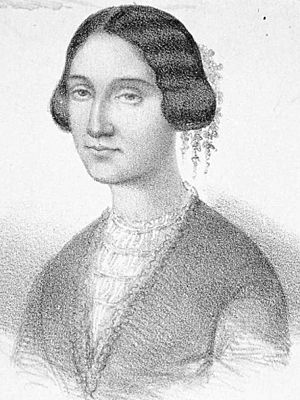Dolores Cabrera y Heredia facts for kids
Quick facts for kids
Dolores Cabrera y Heredia
|
|
|---|---|

Lithograph portrait by Leopoldo López de Gonzalo
|
|
| Born | 15 September 1828 Tamarite de Litera, Spain
|
| Died | 1 December 1899 (aged 71) Zaragoza, Spain
|
| Occupation | Writer |
| Spouse(s) |
Joaquín María Miranda
(m. 1856; died 1884) |
Dolores Cabrera y Heredia (born September 15, 1828 – died December 1, 1899) was a Spanish writer. She wrote many Romantic poems and novels. Dolores was born in Aragon, Spain. She moved around Spain a lot, first with her father, who was a soldier, and then with her husband. She was very good at writing poetry from a young age and continued to write for most of her life.
Contents
Biography
Dolores Cabrera y Heredia was born in Tamarite de Litera, Spain, on September 15, 1828. Her parents were Gregoria Heredia Godino and Lorenzo Cabrera Purroy, who was a soldier. She went to school at the Monastery of Las Salesas in Calatayud. Because her father was a soldier, her family moved often. She lived in Pamplona (from 1844 to 1846), Madrid (from 1846 to 1851), and Jaca (in 1851).
From a very young age, Dolores loved writing poetry. Her mother sent some of her poems to a friend, Pedro de la Hoz, who was the director of a newspaper called La Esperanza (The Hope). He published one of her poems right away in 1847. After that, Dolores became a regular writer for many newspapers and magazines. She wrote for El Correo de la Moda (The Fashion Courier) often. For this magazine, she wrote poems, historical articles, and stories about famous women. She also published her novel Una perla y una lágrima (A Pearl and a Tear) there. This story was based on an old Spanish legend.
In 1856, she married Joaquín María Miranda, who was also a soldier, in Madrid. She traveled with him to Valencia, Granada, and Saragossa. They had four children together. Her husband passed away in Ocaña, Spain on July 24, 1884.
Dolores published her novel Quien bien ama nunca olvida (Who Loves Well Never Forgets) in 1850. She also released a collection of poems called A S.M. el Rey en la muerte de su inocente y augusto hijo el Príncipe de Asturias (To H.M. the King on the death of his innocent and august son the Prince of Asturias) in the same year. Her poems also appeared in other books like Escritoras españolas contemporáneas (Contemporary Spanish Women Writers) in 1880. She even wrote the words for the "Hymn of Alfonso XII."
Dolores Cabrera y Heredia died in Saragossa on December 1, 1899. Her remains were later moved to Madrid in 1911.
Las violetas poetry collection
In 1850, Dolores Cabrera y Heredia's book of poems, Las violetas (Violets), was published. The book had 76 poems that she wrote between 1847 and 1850. The title "Violets" was chosen because the smell of violets reminded her of her childhood. Many of her poems in this book are dedicated to her family, like her mother, father, and sisters, as well as her friends.
In her poetry, Dolores often used nature to show how she was feeling. She also wrote about ruins as a symbol of the end of life. She used common Romantic images like storms and ghosts. When she wrote about love that wasn't returned, her poems became more personal and heartfelt. She connected the idea of love with the flowers that gave her book its name. Some of her poems, like "Las golondrinas" (The Swallows), were influenced by the famous poet Gustavo Adolfo Bécquer.
Hermandad Lírica (The Lyrical Sisterhood)
Dolores Cabrera y Heredia became part of a group of Romantic poets called the Hermandad Lírica (The Lyrical Sisterhood). This happened after she published two poems in a weekly magazine called Los hijos de Eva (The Children of Eve). The most famous writer in this group was Carolina Coronado. Other members included Amalia Fenollosa and Robustiana Armiño.
These women were mostly born around the 1820s and came from middle-class families. They taught themselves a lot and supported each other through letters. They often talked about the difficulties women faced, like unfairness and being treated badly. They wanted women to have more access to education, intellectual activities, and to be recognized as writers. Dolores Cabrera y Heredia wrote about the problems these women writers experienced.
Recognition and honors
Dolores Cabrera y Heredia was very popular with both the public and critics. She received several awards for her writing. In 1860, she became a member and professor at the Academy of Sciences and Letters of the Artistic and Literary Lyceum of Granada. In 1865, she was made a faculty member of the Literature Section of the Artistic and Literary Lyceum of Zaragoza. In 1869, she joined the Artistic and Women's Literature Athenaeum in Madrid.
In her later years, Dolores became blind. A writer named Jerónimo Borao dedicated a poem to her in 1874, called "To Dolores Cabrera de Miranda: Distinguished Poet Deprived of Sight." Another poet, Miguel Agustín Príncipe, also dedicated a fable to her in his book of fables in 1861.
See also
 In Spanish: Dolores Cabrera y Heredia para niños
In Spanish: Dolores Cabrera y Heredia para niños

